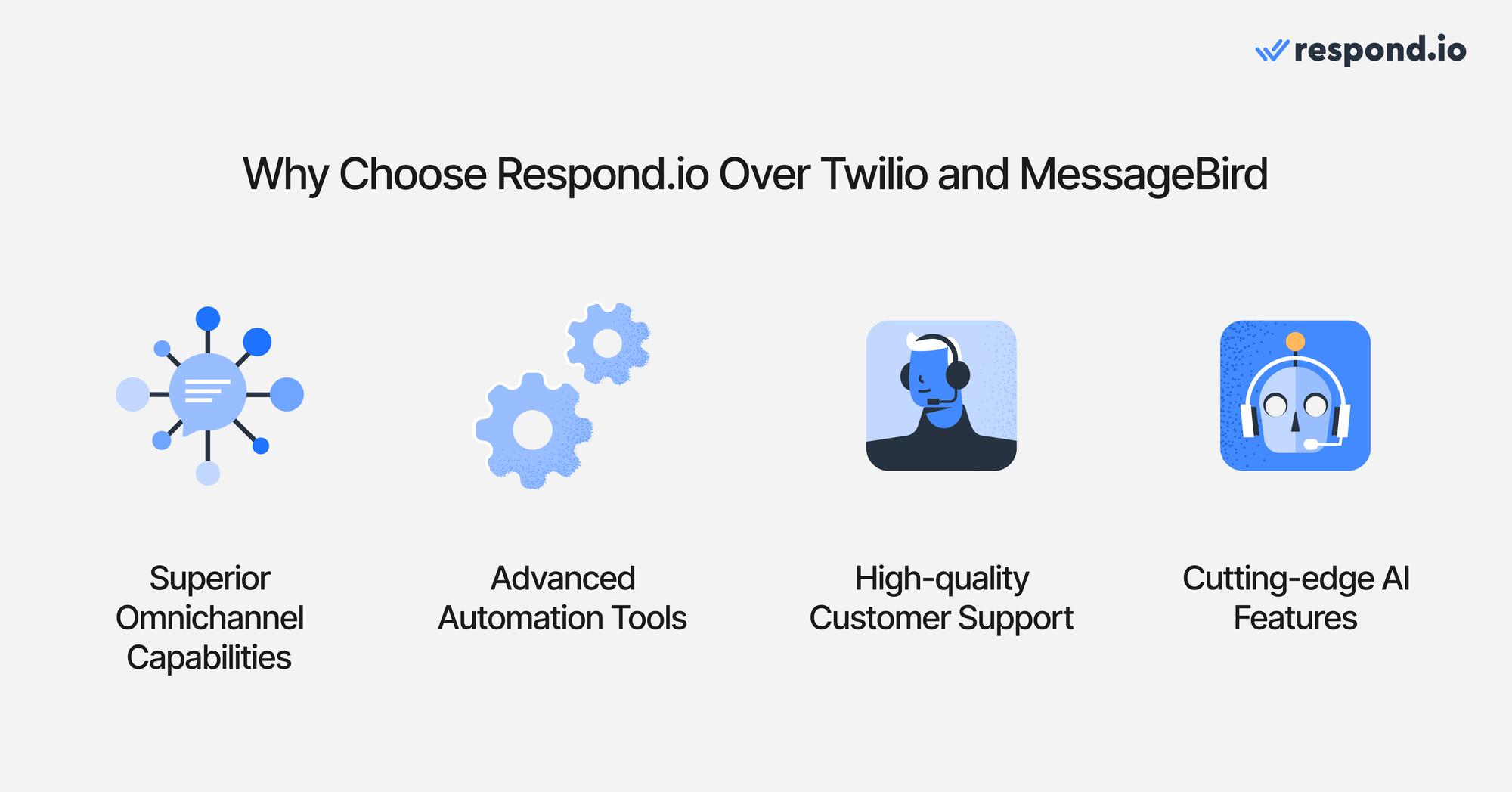
We get it – finding the right customer conversation management software can feel overwhelming with so many options out there. It’s tough to compare them when features aren't always clear and technical jargon complicates things further. That’s where we come in. In this article, we’ll break down Twilio vs MessageBird vs respond.io, three of the most popular messaging platforms. We’ll cover their key features, pricing, and value so you can make an informed choice for your business. Let’s dive in!
Twilio vs MessageBird vs Respond.io At a Glance
Twilio, MessageBird (now known as Bird) and respond.io are built to manage customer conversations from instant messaging channels and SMS. However, the way these platforms deliver to users is very different.
These platforms are ideal for different use cases. Check out the image below to get a quick summary.
Twilio | MessageBird | Respond.io | |
|---|---|---|---|
Channels Supported | SMS, WhatsApp, voice call | SMS, WhatsApp, Messenger, Telegram, LINE and Email | All popular channels, including WhatsApp, WhatsApp call, VoIP, Facebook Messenger, Instagram, SMS, Email, Telegram, Viber, LINE and custom channels |
Multichannel Broadcast | SMS only | SMS and WhatsApp only | WhatsApp, Messenger, LINE, Viber, Telegram, SMS |
External Integrations | Extensive integration support | Extensive integration support | Extensive support for custom APIs, webhooks CRM and popular third-party platforms like Zapier and Make. |
Automation Capabilities | Visual workflow builder | Visual workflow builder | Advanced visual Workflows builder |
AI Capabilities | AI Agent (developer preview only) | Agent Assistant, Content Assistant, FAQ Assistant | Autonomous AI Agents that manage chats and processes |
Customer Support | Free and paid support; 24/7 availability | Starting $500 for customer support; 12/5 availability | Support included; 24/5 live chat and call multilingual support, 24/7 AI support |
Platform Stability | No public uptime statistics available | No public uptime statistics available | 99.9996% uptime |
Reporting | Detailed analytics | Analytics on channels, campaign and subscribers only | Real-time, advanced reporting insights |
Free Plan | Free plan available with very limited features | No free plan, but offers a trial | No free plan, but offers a 7-day free trial |
Starting Price | N/A (pay-as-you-go model) | From 45/month | From $79/month |
Here’s a breakdown of what you need to know:
Twilio: It’s a platform designed primarily for businesses that prioritize SMS communication. However, due to its technical complexity, implementing Twilio often requires developer expertise, making it less user-friendly for non-technical teams.
MessageBird: It positions itself as a CRM solution aimed at supporting marketing, service, and engineering teams. Its core strength lies in SMS communication, but it also offers integrations with other messaging channels like WhatsApp and Messenger. However, as its main focus is on SMS means, it’s not fully optimized for businesses looking for comprehensive omnichannel solutions.
Respond.io: A customer communication management software that excels in sales and marketing via the most popular messaging channels. It’s known for being feature-rich, its reliability and scalability, enabling businesses to efficiently handle high volumes of messages without disruptions, making it ideal for managing omnichannel customer interactions seamlessly.
Want to learn more? Keep reading to see how which of these platforms are the right fit for your business.
Feature Comparison: Twilio vs MessageBird vs Respond.io
Twilio, MessageBird and respond.io have an extensive suite of features that enable businesses to connect to customers. In this section, we’ll break down the key features of each platform, comparing their strengths in messaging, automation, omnichannel support and scalability.
Connecting All Your Channels In One Place With Omnichannel Messaging
Omnichannel messaging allows businesses to engage customers across multiple channels, including SMS, social media, email, messaging apps or custom channels, in a seamless and consistent experience. This approach ensures businesses can connect with their audience on their preferred channels.
Here are some key features to look out for:
A unified inbox, combining various channels like SMS, WhatsApp, Messenger, VoIP and custom channels like e-commerce inboxes.
Integration with various CRMs.
The ability to merge duplicate contact details.
Together, these features enable teams to manage all customer interactions efficiently from one platform. These capabilities save time, reduce errors, and ensure messages are personalized based on the customer's complete interaction history.
Twilio | MessageBird | Respond.io | |
|---|---|---|---|
Available Channels | SMS, WhatsApp, Messenger | SMS, WhatsApp, Messenger, Instagram, LINE, LinkedIn, Email and voice call | SMS, WhatsApp, WhatsApp call, VoIP, Messenger, Instagram, Telegram, LINE, Viber, WeChat, Email, Web Chat and custom channels |
CRM Integration | Native integration with Salesforce; build-your-own integration with other CRMs or integrate through a Twilio CRM partner | CRM integrations through the Integrations marketplace | Connect to CRMs like HubSpot and Salesforce, and 1000+ other integrations |
Merge Duplicate Contacts | No | Manual contact merge | Automatic contact merge suggestions |
When it comes to omnichannel messaging, this is how our three challengers compare.
Twilio: It supports SMS, WhatsApp, and Messenger, but not custom channels. It also provides native integration with Salesforce. For large businesses with wide presence, this is usually not enough. If you use other CRMs, you’ll need to build your own integration or integrate your CRM through Twilio’s CRM partners. It also requires manual merging of duplicate contacts.
MessageBird: Offers a wider range of channels including SMS, WhatsApp, Messenger, Instagram, LINE, LinkedIn, Email, and voice call. However, it doesn’t support any custom channels. You can connect CRMs through its Integrations marketplace. However, it lacks a feature for merging duplicate contacts automatically, meaning you’ll need to resolve duplicate contacts directly in your CRM.
Respond.io: Stands out with the most extensive channel support, including SMS, WhatsApp, Messenger, Instagram, LINE, Telegram, Viber, WeChat, Email, Web Chat, and custom channels. What's more, it's one of the few BSPs offering both WhatsApp Business Calling API and VoIP. Respond.io also integrates with your CRM and other integrations via Zapier and Make. Plus, it has the added benefit of automatic contact merge suggestions, making contact management easier.
Capture More Leads with Growth Tools
Lead-capturing tools are crucial for businesses to increase the number of opportunities to convert prospects. These tools include click-to-chat ads, QR codes and widgets, all of which help streamline the process of engaging potential customers, collecting their contact information, and initiating conversations that can lead to conversions.
Twilio | MessageBird | Respond.io | |
|---|---|---|---|
Click to Chat Ads | Yes | No | Yes |
QR codes | Yes | No | Yes |
Widgets | Yes (limited to webchat only) | Yes | Yes |
Regarding lead-capturing, this is what to expect from Twilio, Messagebird and respond.io.
Twilio: Requires you to set up event streams to integrate with click-to-chat ads. It also supports QR codes and provides widgets, though its chat widget support is limited to webchat — there are no other channel-specific chat widgets.
MessageBird: It does not support click-to-chat ads or QR codes, but it does offer widgets, allowing businesses to embed forms or chat interfaces on their websites for lead capture.
Respond.io: It provides a robust integration for click-to-chat ads, ensuring agents are aware when conversations originate from these ads. There is also full support for QR codes, and an omnichannel widget, making it an effective tool for capturing leads across various channels and touchpoints.
Turn customer conversations into business growth with respond.io. ✨
Manage calls, chats and emails in one place!
Converting Prospects Efficiently with Automation and AI
Larger businesses have many inbound messages to process every day. It’s not practical to hire dozens or even hundreds of human agents to do simple processes and tasks. This is where automation and AI come in.
They have the ability to automate simple, repetitive tasks like sending greeting or away messages. And with AI, businesses can even automate entire processes like lead qualification and distribution to further lower effort on less important activities. This frees up the human agents’ time to perform more important tasks like closing sales.
The key features to look out for include automation capabilities, AI Assistants, AI Agents and the ability to train your AI based on knowledge sources.
Twilio | MessageBird | Respond.io | |
|---|---|---|---|
No-code Automation | Automation builder | Two different automation builders for messaging and processes | Advanced automation builder |
AI Assist | No | Agent Assistant, Content Assistant, FAQ Assistant | AI Assist AI Prompt |
AI Agent | Only available to developers | Yes | Yes |
AI Knowledge Training | Yes | Yes | Yes |
Let’s see how Twilio, MessageBird and respond.io compare in terms of Automation and AI.
Twilio: It has an automation builder and AI capabilities. However, to utilize the Twilio AI Assistants, you’ll need to be a developer first and join a waitlist. Agents aren’t given text improvement or generation tools to speed up their responses. The good news is that all customer data is used as knowledge training for Twilio AI Assistants.
MessageBird: There are two kinds of automation tools, one for messaging and the other for business processes. To make things more confusing, there are three types of AI Assist tools that essentially improve the response of agent. To use the AI Agent, you’ll need to build a knowledge base first by uploading documents (like FAQs and product lists), set it up and then deploy it.
Respond.io: Respond.io's Workflows automation builder enables you to build no-code automation that can handle everything from assigning conversations to an agent to qualifying leads. Or you can simply use templates to create AI Agent with specific roles that learns from your knowledge base. AI agents can understand photos and voice messages, make personalized product recommendations and even answer calls. Human agents get tools like AI Prompt to improve their response or generate an entire message based on the flow of the conversation. Like with Twilio and MessageBird, you can upload knowledge sources to improve the AI agent's responses.
Retaining Customers for Repeat Sales with Broadcasts
Even though businesses convert leads into paying customers, still more opportunities abound. Through broadcasts or bulk messages, you can gain additional sales from the same customer.
Broadcasting messages are an excellent way to promote your products. And with reporting and analytics, businesses can learn which campaigns work best to pour additional resources into it.
Twilio | MessageBird | Respond.io | |
|---|---|---|---|
Supported Broadcast Channels | SMS only | SMS and WhatsApp | WhatsApp, Facebook Messenger, SMS, Telegram, Viber, LINE |
Broadcast Analytics | Delivery, Failure | Delivery, Reads, Breakdown by channels | Delivery, Reads, Failures, Channel-specific filters |
If you’re looking for the best broadcast tool, respond.io won’t disappoint you. Here’s why.
Twilio: Unfortunately, Twilio only supports broadcast messages on SMS, limiting the number of opportunities you can generate from a campaign. While you can get information like delivery and failure rates, there are a series of highly technical steps to go through to view the reports.
MessageBird: It's limited to SMS and WhatsApp. MessageBird also has analytics that includes delivery rates, read rates and breakdown by channels, which you can further filter by date ranges.
Respond.io: You can broadcast on many channels, including WhatsApp, Instagram, Facebook Messenger, Viber, Telegram, LINE, WeChat and SMS. Through the Reports Module, you can gain in-depth analytics like delivery, read and failure rates. You can also further filter the report by channel and date ranges.
Messaging Insights with Reports & Analytics
Messaging customers or launching campaigns alone aren’t enough for growing businesses. They need data to inform their future strategy and tactics for improvement.
Twilio | MessageBird | Respond.io | |
|---|---|---|---|
Conversion Tracking | No | No | Yes |
Agent Performance Analytics | Yes | Yes | Yes |
Custom Reports and Dashboards | Yes | Yes | Yes |
Data Export | Yes | Yes | Yes |
Here’s how all three platforms stack up when it comes to reporting and analytics.
Twilio: There isn’t a way to track conversions on Twilio. However, agent performance analytics is available via Flex Insights, which provides granular data on individual conversations and agent performance. Twilio supports custom reports and dashboards, which can be tailored to specific KPIs through its Flex Insights dashboards. Additionally, data export is supported via Twilio’s BulkExport API, which allows for the export of historical data, like message records, in a compressed format for further analysis.
MessageBird: While there isn’t a way to track conversions, businesses can oversee individual agent metrics like first response time. MessageBird does offer custom reports and dashboards, allowing businesses to visualize key data points. Reports can also be downloaded as a CSV file.
Respond.io: It can track conversions sourced from websites through the Growth Widget along with tracking the entire customer lifecycle and providing in-depth lifecycle reports. Its agent performance analytics is highly detailed, offering metrics on response times, resolutions, and individual agent performance through customizable reports and dashboards. Additionally, respond.io allows for flexible data export, supporting various formats like CSV and real-time data transfer to external platforms, making it an optimal choice for businesses that require comprehensive, actionable insights.
We've covered plenty of great features. However, features can only take customer conversations so far. A reliable, stable platform with quality support is just as important too.
Platform Stability and Customer Support
Imagine this: your business needs to handle thousands of messages every day, but then errors keep occurring. You need two things.
A platform that’s stable enough to handle your operations.
A great customer support team to assist with your issues.
Let’s see how these platforms compare.
Scalable Stable Platform
Businesses should consider platform stability as important as feature set — great features mean very little if you’re not able to use your platform consistently for the vast majority of the time.
Platform Stability | |
|---|---|
Twilio | N/A |
MessageBird | N/A |
Respond.io | 99.9996% Uptime |
Here’s how Twilio, MessageBird and respond.io compare in terms of platform stability
Twilio: While there are no public uptime statistics, customers report Twilio to be scalable and reliable.
MessageBird: Again, there are no public uptime statistics. Unfortunately, MessageBird doesn’t provide a status page, which makes tracking incidents difficult.
Respond.io: Boasting an extremely stable and reliable platform, respond.io has a 99.9996% uptime. It enables businesses to scale without facing any performance limitations.
Level of Customer Support
Eventually, every business will face some issues with the services they are using. When this happens, they need exceptional customer support to get them through that difficult period. A great level of support can go a long way to mitigate any potential losses a business might go through during downtime.
Support Hours | Multilingual Support | Support Included for Free? | Additional Fees | |
|---|---|---|---|---|
Twilio | 24/7 (No guaranteed response time for free plan) | No | Yes | Starting from $250/month for priority, live chat and phone support |
MessageBird | 12/5 (Paid support only) | No | No | Starting from $500/month |
Respond.io | 24/5 live chat and call support, 24/7 AI support | Yes | Yes | No, all plans are treated equally |
So, which solution offers the best customer support? We break it down for you.
Twilio: While it offers 24/7 support, under the free plan, you only have access to the AI Help Center assistant. For priority support and to get access to additional channels like live chat, phone support and more, you’ll need to pay at least $250 per month.
MessageBird: Unfortunately, it does not offer any customer support by default. Businesses need to pay at least $500 for customer support.
Respond.io: It’s available 24 hours a day via call and live chat at no additional cost, from Monday to Friday, covering English, Arabic, Chinese and Spanish support. Businesses on higher tier plans are also given a dedicated Customer Success Manager who will help you connect channels or set up Workflows for an even smoother experience.
Next, let’s get to the most important part of any service: the value.
Maximize Every Dollar You Spend
All three platforms have very different pricing models, which makes them hard to compare. So, for this section, we’ll look at the base cost of using the platform and any additional costs businesses incur.
Price per Month | Additional Fees | Support | Automation | Additional Seats per Month | |
|---|---|---|---|---|---|
Twilio | - | SMS Fees: $0.0463 per message WhatsApp Fees: $0.005 per message sent and received | Included | 100 automation triggers /month free; $0.06/automation triggers | $15 |
MessageBird | From $45 | SMS Fees: $0.0288 per message WhatsApp Fees: $0.005 per message sent | From $500 | 1,000 free invocations per month; custom pricing per invocation | $30 (3-10); $27(11-25) |
Respond.io | From $79 | No | Included 24/5 live chat and call multilingual support, 24/7 AI support | Included in Growth, Advanced and Enterprise plans | From $12 |
If you are looking for a brief summary, this is the value you’ll get from Twilio, Messagebird and respond.io.
Twilio: It offers a pay-as-you-go model, which sounds great if you have fluctuating needs. However, Twilio adds a markup to every SMS and WhatsApp message sent. While this is great if your customer base is small, it becomes very expensive to scale up. Adding users is also very expensive, with seats costing $30 per user.
MessageBird: While it appears as if it offers a very affordable plan, when factoring in the support and automation costs, the price quickly ramps up. A growing business or enterprise will find it hard to justify the massive costs involved. This is only made worse with the additional seats per user per month, which is the most expensive among the three platforms.
Respond.io: Provides transparent and competitive pricing with its Starter, Growth, and Enterprise plans, and, what’s better, no markup fees per message. Respond.io offers a comprehensive set of features even at the Starter plan at $79 per month. However, even if you upgrade your plan, the feature set and support available to businesses let you recoup your investment in no time.
So, now that you know how all three platforms stack up, which should you choose?
The Verdict: Why You Should Choose Respond.io
Respond.io offers exceptional value for businesses seeking a versatile and scalable messaging platform. Its extensive omnichannel capabilities support all major messaging channels including voice, making it ideal for companies looking to enhance their sales and marketing efforts.
With advanced automation tools, robust customer support, and powerful reporting and AI features, respond.io streamlines operations and elevates customer engagement across multiple platforms.

While Twilio and MessageBird are strong options, they primarily focus on SMS and voice communications. With WhatsApp Business Calling API now available in multiple countries like Mexico, Singapore and the UK, respond.io also offers voice communications through the most popular social app along with VoIP via Telnyx.
In summary, respond.io remains the superior choice for businesses that need a comprehensive, multichannel AI-powered messaging platform with competitive pricing.
Turn customer conversations into business growth with respond.io. ✨
Manage calls, chats and emails in one place!
Further Reading
Did you enjoy reading this article? Then check out these customer conversation management software comparisons:






































 Electronics
Electronics Fashion & Apparel
Fashion & Apparel Furniture
Furniture Jewelry and Watches
Jewelry and Watches
 Afterschool Activities
Afterschool Activities Sport & Fitness
Sport & Fitness
 Beauty Center
Beauty Center Dental Clinic
Dental Clinic Medical Clinic
Medical Clinic
 Home Cleaning & Maid Services
Home Cleaning & Maid Services Photography & Videography
Photography & Videography
 Car Dealership
Car Dealership
 Travel Agency & Tour Operator
Travel Agency & Tour Operator




